In a state with a great abundance of unique and diverse architectural treasures, the other-worldly Bavinger House in Norman is considered by many to be Oklahoma’s — and even the nation’s — finest example of organic Modernism.
And now, sadly, it may be lost forever. But, more about that in a bit. Let’s start at the beginning of the story, not the end.
During famed architect Bruce Goff’s tenure as the head of OU’s School of Architecture in the late 40’s, he met a young art professor there named Eugene Bavinger. Although Goff was 15 years Bavinger’s senior, the two men must have recognized in each other a shared spirit of adventure and non-conformity. So, perhaps it’s no coincidence that they came together during the optimistic post-war boom years to create a structure that many would only loosely identify as a house but most would recognize as a true work of art.
Bavinger and his wife, Nancy, who was also a talented artist in her own right, wanted to break away from the typical box-like house they were living in; instead, they wanted a home that was open and flexible and had room for the Bavingers’ tropical plants and fish — and for their two small boys. In addition, as creative souls, they wanted a house that embodied art itself. So, let’s recap: no boxes; open; room for fish, plants, and kids; and artistic — all in one building — and all on an art professor’s meager budget. Those requirements might prove to be more than daunting for less imaginative architects, but not for Goff. After just one meeting with the Bavingers, he came up with the fundamental design for their new house — a spiraled DNA helix that rose three stories and contained not a wall one (well, okay, maybe one wall for the bathroom, but really, that’s the only one):
Instead of bedrooms, the Bavingers and their tots would sleep and live in UFO-like, carpet-covered pods suspended from the same cables that also held up the roof that grandly wound its way up 55′ to a tight spire on top:
All I can say is that Nancy Bavinger must have been a very brave woman to agree to such a set up with two rambunctious monkeys — I mean boys — crawling, jumping, swinging, climbing, and running everywhere. Very brave, indeed (and I say that from exhaustive experience as a parent of two such bizarre creatures of my own).
Once Goff completed his inspired design, Bavinger took up the helm and set out to build this most unusual residence. Since he had very little money, he enlisted some of his and Goff’s most enthusiastic (or some might say crazy) students to drive to his wooded acreage, complete with babbling brook, during time off to labor on his dream. They did, and very happily, too. Using 200 tons of locally quarried rock, Goff’s signature aqua glass cullets, used oil rigging equipment and parts, WWI stainless steel aircraft struts, and any other leftovers they could scrounge, the students and Bavinger toiled on weekends and holidays through the frigid cold of Oklahoma winters and the sweltering heat of Oklahoma summers.
Word soon spread that a very strange structure was being built on the prairie outside of town, and people began arriving by the busload to check it out. Soon, so many tourists were coming that the industrious Bavingers began charging admission — $1 per person. Within a short amount of time, the struggling family had earned thousands of dollars from the curious, and oftentimes dumbfounded, spectators.
After five long years, the home was finally completed in 1955.
A masterful blend of organic and modern design, the house was everything the Bavingers hoped it would be. The natural stone walls that literally arose from the red earth itself contained shelves and planters for Eugene Bavinger’s beloved tropical plants, while a pond snaked through the bottom level, providing a home for his fish (and I’m sure some lively swimming and perhaps a little fishing for the small Bavinger boys).
A modern kitchen and dining area also made up the first level of the home. The home’s backbone, a spiral staircase, allowed access to the living room and bedroom pods (complete with fishnetting to prevent the little ones from toppling out), as well as Eugene’s clerestory studio on the uppermost level.
Soon after the family moved in, the press came a-calling. The most archetypically American periodical of the day, Life Magazine, published a profusely illustrated, two-page spread on what it dubbed the “space and saucer house.” Various architectural magazines also profiled what was quickly becoming referred to as Goff’s masterpiece, but the glory was soon overshadowed by his abrupt move from OU to Bartlesville in 1956.
Even though he was gone, Goff and Bavinger’s jaw-dropping, crazy dream continued to bewilder, baffle, and even bemuse as the Bavinger boys grew up and Gene and Nancy grew older. In 1987, the home was awarded the prestigious Twenty Five Year award by the American Institute of Architects, and it was placed on the National Register in 2001, four years after Gene’s death. Nancy followed her husband soon after the designation.
By the late 2000’s, the aging Bavinger House was in serious need of restoration. The skylights that spiraled up along with the roof leaked, some of the cabling needed repair, the pods were in sad shape, and the wood and shingles were rotting.
Gene and Nancy’s youngest son, Bob, once again opened the house for tours to raise awareness and funds for the restoration effort, but, as often happens, the money didn’t pour in as he must have hoped, especially from organizations that were also concerned with preserving the home. Over time, tempers flared, and the situation grew more and more bleak for Oklahoma’s most unique residence.
So, this is where the story gets a bit murky and a lot sad.
A few days ago, Bob Bavinger contacted one of the organizations he’s been feuding with and claimed that he tore the house down “to the ground.” He also made the same claim to numerous people (myself included) who called to verify his claim. Immediately, frenzied emails and Facebook posts from all over the country started flying around, news organizations were called, and a few brave, diehard Bavinger House fans made the trek to Norman to determine the condition of the home for themselves. The news was not good.
While the house itself has not been torn down to the ground as Bob claimed, it does look like it has sustained significant damage, as you can see in this not-so-great photo taken today:
That’s the top spire of the house you see tilted over at a 45 degree angle. According to those in the know (i.e., a couple of my architecture buddies), the spire housed all of the structural cables that held up the roof and room pods. With the failure of the spire, it is entirely possible that the rest of the roof and house sustained catastrophic damage. Unfortunately, the Bavingers haven’t let outsiders onto the property to assess the damage, but a post to the Bavinger House website today says that the home is closed due to storm damage and will not re-open.
So, did Bob destroy is own home? Did he really obliterate his parents’ beautiful legacy and Goff’s most identifiable work, or did last week’s terrible storm that ripped through Norman topple the spire, as Bob now seems to claim? I don’t know, and, truthfully, I really don’t care. I just want to know if this greatest of Oklahoma’s treasures can be saved and, if so, what needs to be done to do so. Unfortunately, without Bob’s cooperation, even learning that little bit of information may prove difficult.
And, that’s where the story ends for now.
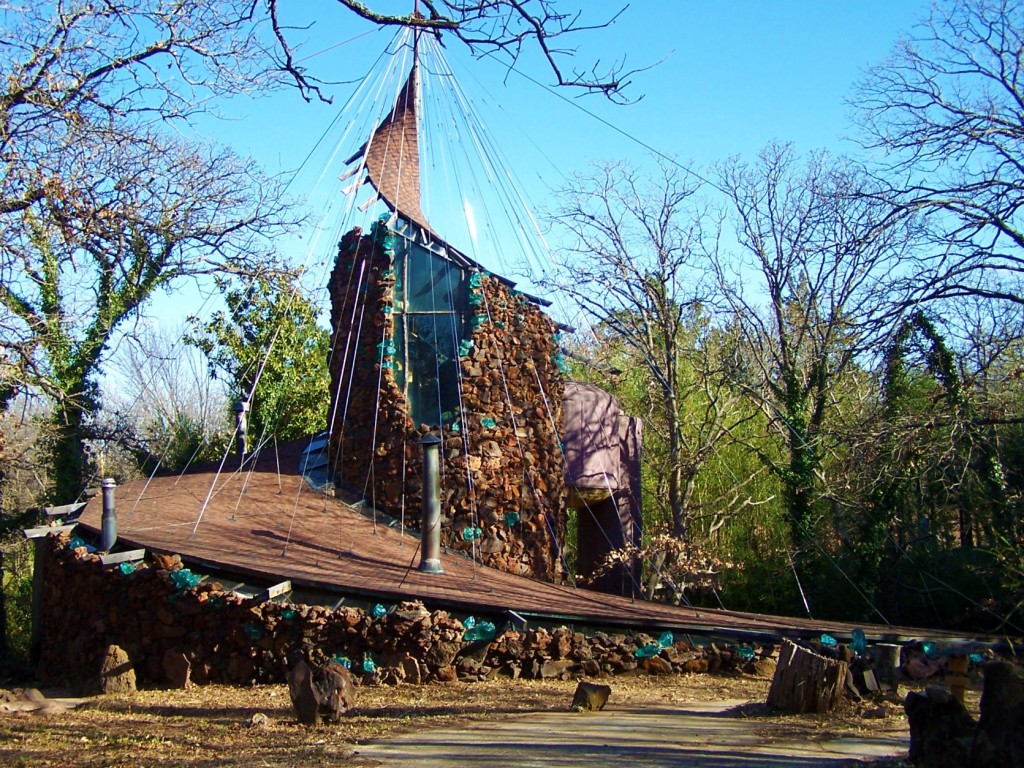
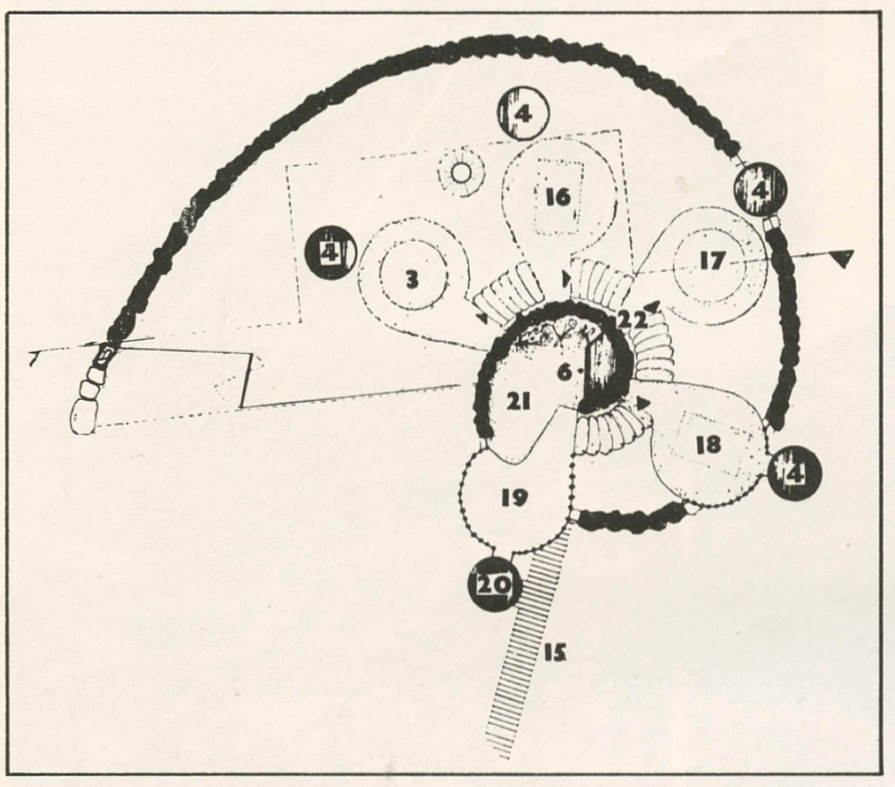
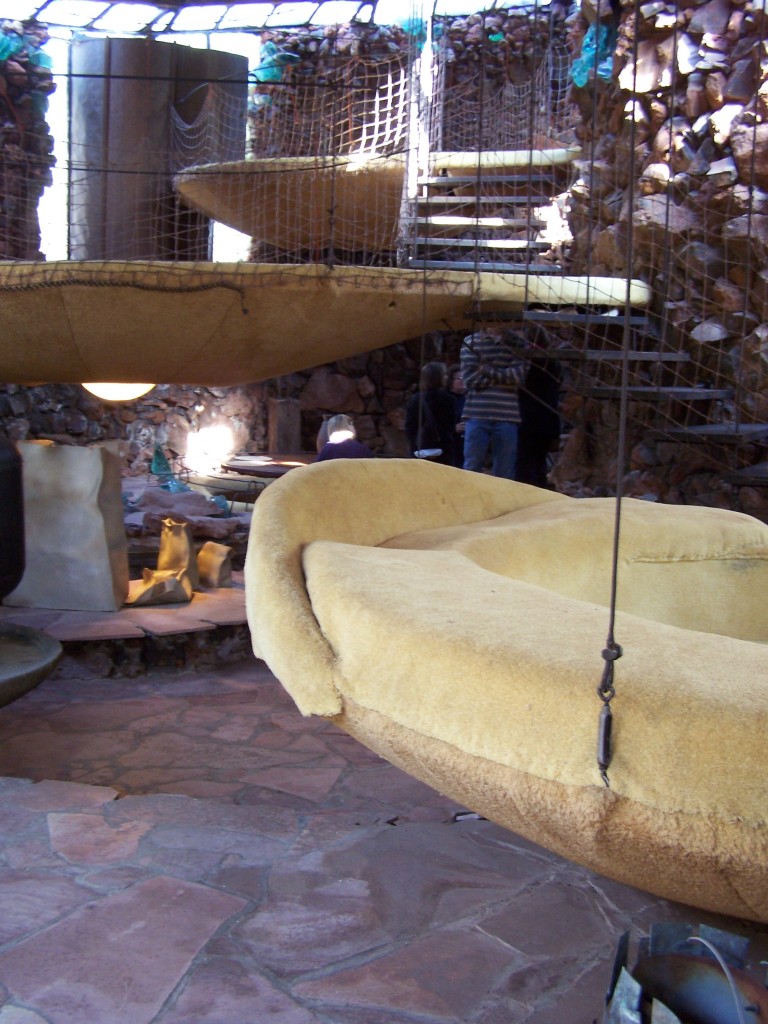
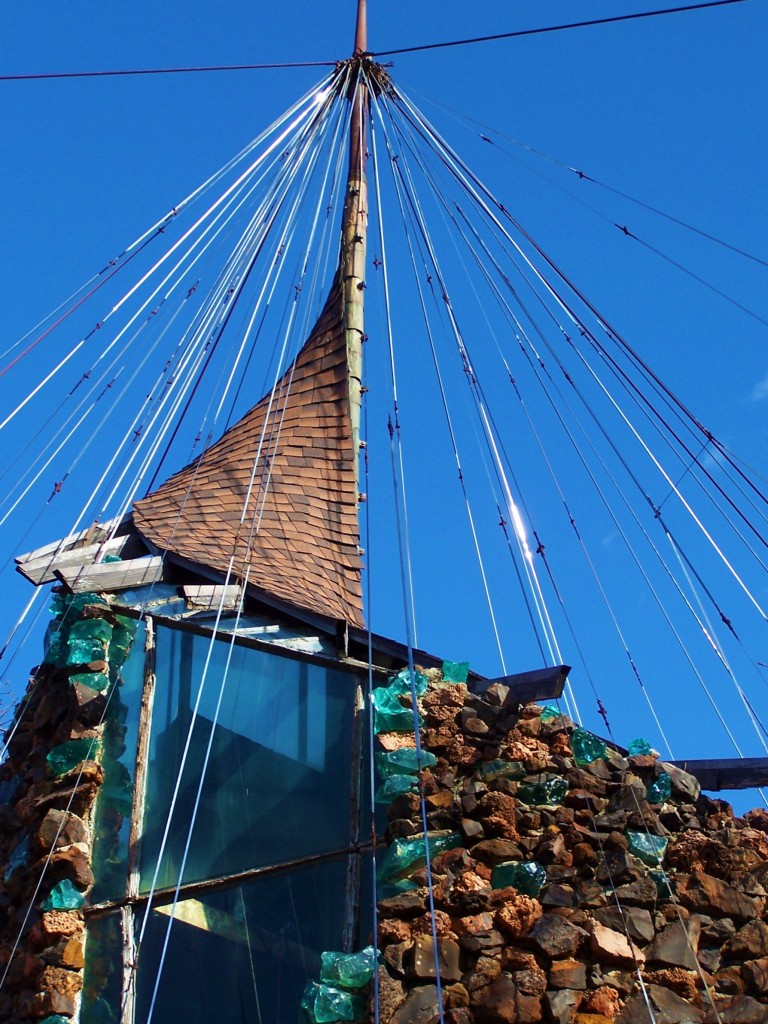
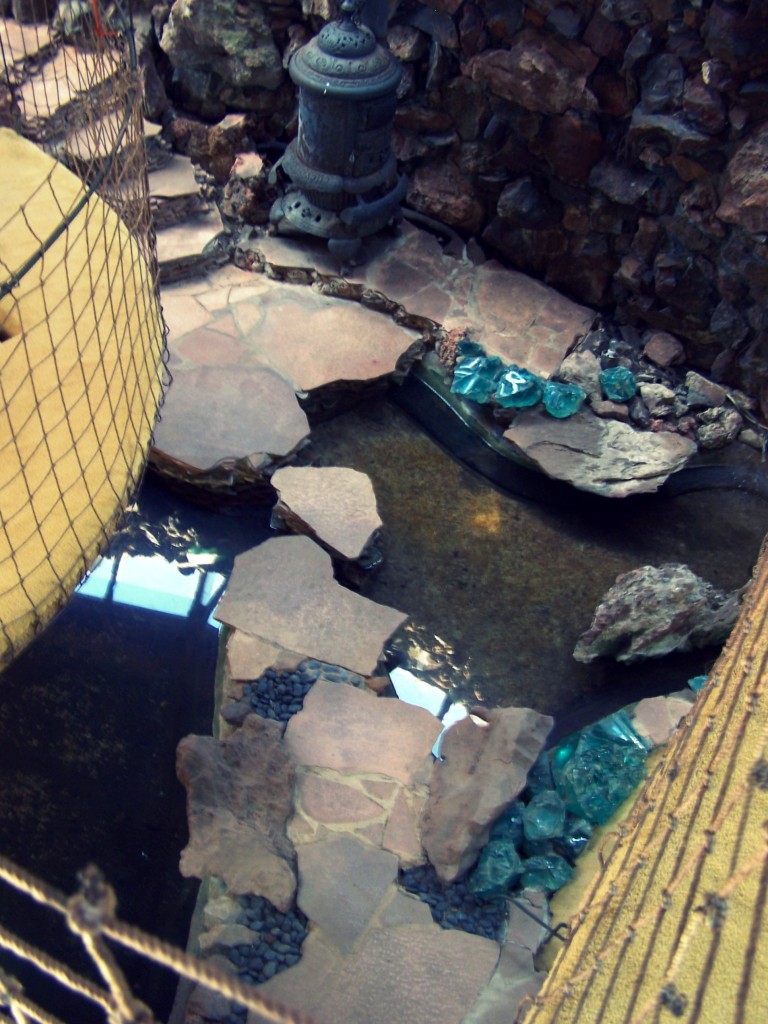
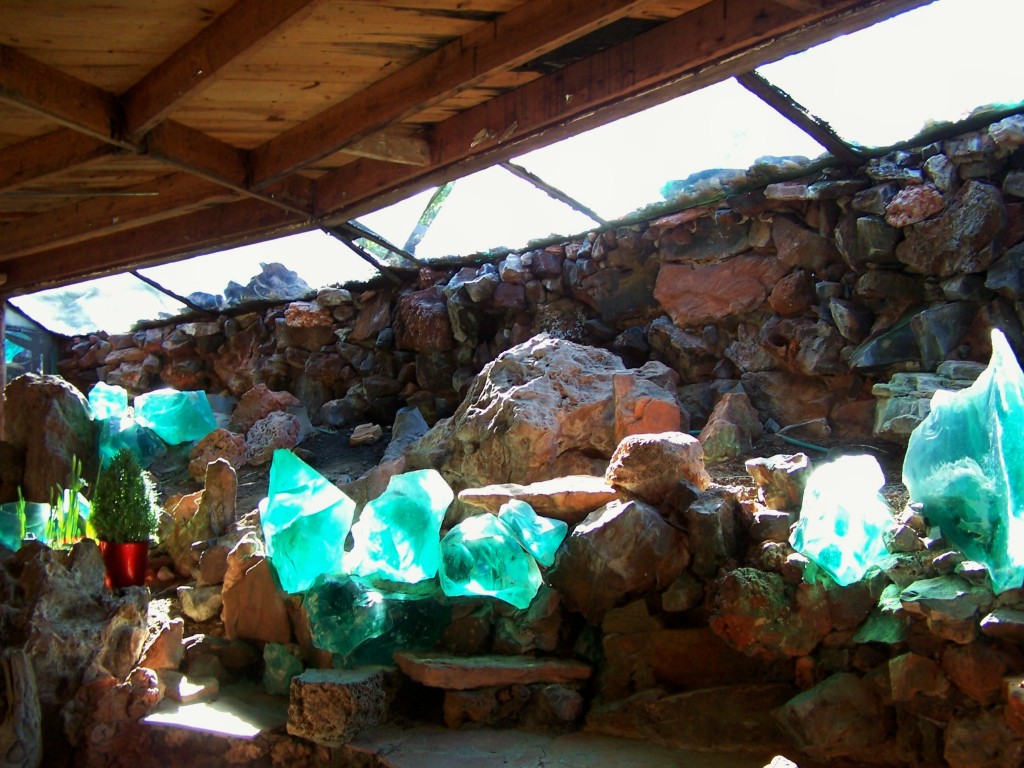
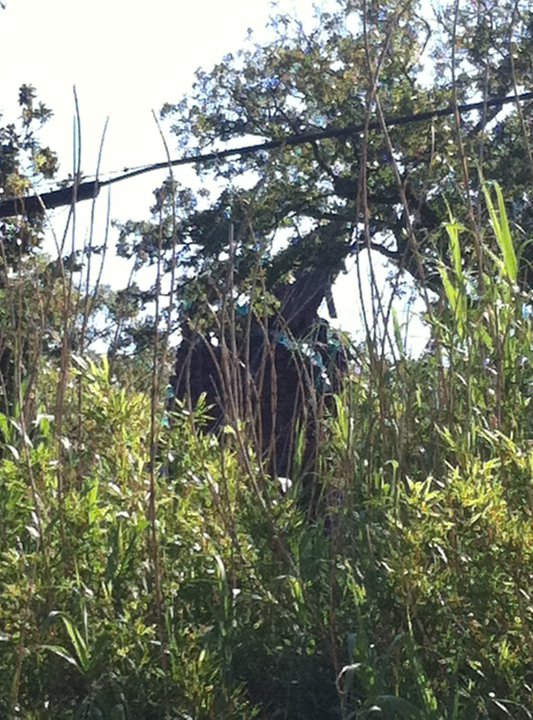
Thank you Lynne. Excellent article and update on this zany situation.
Pingback: dustbury.com » Bavinger hunt
I had no idea this masterpiece was in such a state. Thanks for letting everyone know about this, Lynne. Perhaps enough people will hear about this tragedy that something positive can be done to save this landmark.
Thank you, Lynne, for the update. I believe those saying the storm probably didn’t do the damage described may not be seeing things clearly. The weight of the roof, part of the stairs and three bowls is counterweighted by a suspension bridge on the opposite side of the mast. The mast functions as a fulcrum (think the midpoint on a teeter-totter). If a microburst of air struck the bridge in the right way, it is possible for the force from a whipping bridge could cause a 60 year old steel pipe mast to fail. The mast has surely been subject to similar forces over the years. Metal fatigue, probable corrosion and a freak wind appears to have taken its toll.
I also happen to know Gene put in anchors in about 1993 or 1994 to help dampen the bridge motions during windy conditions. 🙂
I hope things work out so the home can be saved. From the photos it looks like a daunting task, though.
Thanks Lynn for the update. Excellent artice. I do hope the house can be restored and used for tours one day before it’s too late.
I enjoy seeing the homes Bruce Goff built. My parents live in one of the Goff Homes that was built in 1964 for Bill and Dotty Dace.
Thank you so much for this article and for trying to reach the owners. I hope this wonderful house can be saved.
Pingback: The 30 Strangest Buildings In The World. I’ve Never Wanted To Travel So Badly. | Dis-tract-ify
Pingback: The 30 Strangest Buildings In The World. I’ve Never Wanted To Travel So Badly. | Viral Feels
Pingback: The 30 Strangest Buildings In The World. I’ve Never Wanted To Travel So Badly. - Fun's Feed